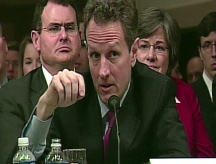Debt prices keep falling
With the banking sector continuing to deteriorate and Obama intent on a stimulus plan, the anticipated supply of Treasurys coming to market depresses prices.
NEW YORK (CNNMoney.com) -- Government debt prices continued to decline Wednesday as the market prepared for unprecedented levels of new issues.
Bond prices have been on the decline as the market braces for the possible impact of President Obama's stimulus plan. The new administration has joined with House Democrats to propose $825 billion in new spending aimed at creating or saving between three million and four million jobs.
With the deficit already expected to top $1 trillion in fiscal 2009, big spending plans - if approved by Congress - mean that the government will have to finance the rescue by selling more debt.
"Basically, everything that the federal government is talking about now involves the issuance of more federal debt," said Pierre Ellis, senior economist at Decision Economics, and the market is questioning whether there is enough demand to sop up supply.
"The weakness in the economy and the fragility of the banking system and the reflection of both those in the stock market and global concern have increased demand for U.S. Treasurys very sharply," Ellis added.
Big name banks have shown signs of continued weakness, even after the government has stepped in repeatedly to prop up the faltering institutions. The deterioration of the banking sector has raised concerns that the government might be called upon to inject even more capital into the nation's financial institutions.
Last week, the government gave Bank of America (BAC, Fortune 500) $20 billion to facilitate its takeover of Merrill Lynch, the second time the government has given Bank of America cash. Citigroup (C, Fortune 500) has also received two jolts of stimulus from the government.
With the nation's banks unable to get footing, the government has considered a return to the original intention of the $700 billion bailout unveiled by the Bush administration last year. The Troubled Asset Relief Program, or TARP, was initially intended as funding to take illiquid assets off the balance sheets of the nation's banks and combine the debt in one "bad bank."
The "bad bank" plan was overturned in favor of what was seen as a more immediate way of getting aid to the faltering banks - direct capital injections and stock purchase plans.
However he chooses to use it, President Obama has been given access by Congress to the remaining $350 billion in TARP funding.
This week alone, the Treasury was scheduled to auction almost $120 billion worth of debt. On Wednesday, the Treasury was set to auction $35 billion worth of cash management bills and $30 billion worth of 4-week bills. On Tuesday, the government auctioned $27 billion worth of 26-week bills and $27 billion worth of 13-week bills.
Inflationary concerns: The Federal Reserve has chopped its key lending rate to a target range of between 0% and 0.25%, and such an expansionary monetary policy, which floods the economy with greenbacks, threatens to devalue the dollar. Meanwhile, with the economy stalled and demand for goods slowing, economists have started seeing signs of falling prices.
The projected level of inflation was adding uncertainty to the Treasury market. Inflation devalues the principal of bonds and depresses demand, whereas deflation supports demand for bond. "There is gross uncertainty as to the outlook for inflation," said Ellis.
In addition, the economy has been struggling in recession for more than a year and the bond market is looking for signs of a recovery. "The market is undecided in which way it is going to go, and that is evident in this volatility in long-term rates," said Ellis.
If the economy were to manage a quick recovery, however, the debt market could struggle to find enough demand for all of the supply coming to market. But Ellis said policy makers "certainly want to get the economy out of this rut before they think too much about taking the stimulus on all fronts away."
Debt prices: The benchmark 10-year note dipped 13/32 to 111 17/32 and its yield rose to 2.43% from 2.38% late Tuesday. Bond prices and yields move in opposite directions.
The 30-year bond fell 1 15/32 to 128 5/32, and its yield rose to 3.05% from 2.97%. Meanwhile, the 2-year note edged less than 1/32 lower to 100 10/32, and its yield held steady at 0.72%.
The 3-month Treasury bill yielded 0.12%, even with Tuesday. The 3-month bill has been used as a gauge of confidence in the marketplace because investors tend to shuffle funds in and out of the bill as they asses risk in other places.
Lending rates: The 3-month Libor rate held steady with Tuesday at 1.12%, according to data available at Bloomberg.com. But the overnight lending rate jumped to 0.19% from 0.14%.
Libor, the London Interbank Offered Rate, is a daily average of rates 16 different banks charge each other to lend money in London, and it is used to calculate adjustable-rate mortgages. More than $350 billion in assets are tied to Libor.
Two credit market gauges were unchanged from Tuesday.
The so-called "TED" spread, a measure of banks' willingness to lend, rose to 1.02 percentage points from 1 percentage point on Tuesday. The lower the TED spread, the more willing investors are to take risks. The rate surged as the credit crisis gripped the economy, but has since fallen off as central banks around the world have lowered interest rates and pumped the economy with liquidity.
Another market indicator, the Libor-OIS spread, narrowed slightly to 0.92 percentage point from 0.93 percentage point on Tuesday. The Libor-OIS spread measures how much cash is available for lending between banks, and is used for determining lending rates. The narrower the spread, the more cash is available for lending. ![]()





